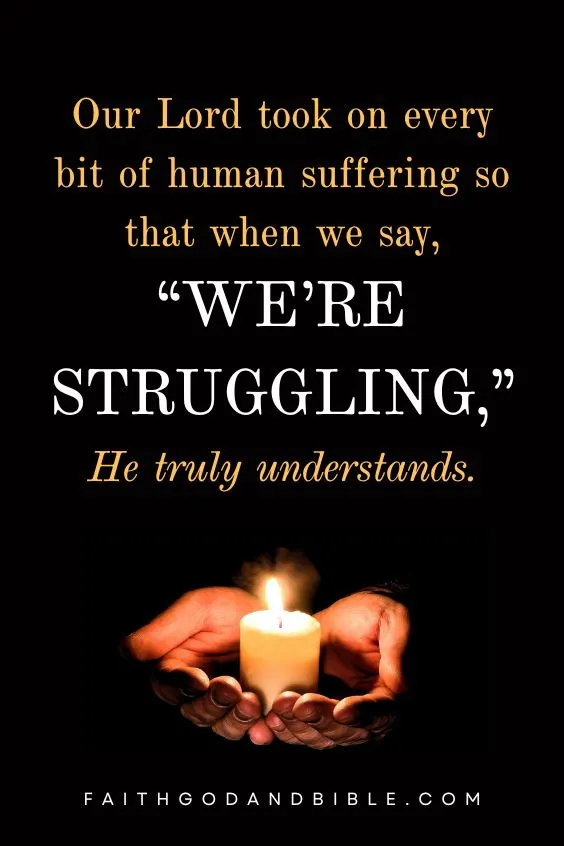In the thick of life’s storms, as we wade through the depths of grief, it often feels akin to stumbling blindly in unfamiliar territory. As followers of Christ, we should turn our eyes toward Jesus for solace and direction.
He was not only divine but was also touched by human sorrows just as deeply. Through my years immersed in Scripture and walking hand-in-hand with many during their season of mourning, I have witnessed how reflecting on Christ’s own journey through sadness offers a glimmering ray of comfort.
When Jesus encountered the shadows cast by death and heartache, He didn’t recoil from the intensity of raw emotion. Instead, He welcomed it with open arms. John 11:35 speaks volumes with mere words—”Jesus wept”—and within that tender moment lies an empathy that breaks through the barriers of time itself.
It serves as a gentle reminder that even when night seems unending, there is solace in sharing our load with one who has navigated similar straits before us. Let’s look closer at His heartfelt approach.

How Did Jesus Deal With Grief?
Jesus as a Model of Dealing With Grief

How Did Jesus Deal With Grief?
In our journey through sorrow, we often look for a beacon of hope to guide us. Jesus embodies this solace, showing us that even in the depths of despair, there is a pathway to healing. His life and actions provide not only a testament to enduring pain but also an intimate understanding, a map for navigating our own grief with grace.
Jesus shares and understands our despair.
We feel deep sadness, and Jesus understands it. He lived as a man, faced tough times, and knew what it meant to hurt inside. In the town of Bethany, when His friend Lazarus died, Jesus saw Mary and Martha in pain. They were heartbroken. And what did Jesus do? He cried, too— “Jesus wept” (John 11:35). That shows us how much He feels for us when we are down.
He’s not just watching from far away; Jesus is right there with us in our dark moments. He felt alone on the cross. Remember His cry in Matthew 27:46? Our Lord took on every bit of human suffering so that when we say, “We’re struggling,” He truly understands. We’re never alone because He’s been through it all before us and stands beside us now.

How Did Jesus Deal With Grief?
His presence and compassion bring comfort.
As we’re feeling sorrow, we must remember we’re never alone. The Holy Spirit is called the Comforter for good reason. He gives us strength and eases our pain. In the Gospel of John, Jesus promises that the Helper will be with us forever (John 14:16). This means that in every tear we shed, God’s love is there to hold us up.
God’s mercies are new every morning, ready to greet us as we face each day’s challenges. When grief feels too heavy, we can find peace knowing that His compassion knows no end. The Lord comforts us so that we can comfort others with the same kind of caring (2 Corinthians 1:3-4). Remember how friends and family came together during the raising of Lazarus. Share your sadness to help heal your heart, and comfort others when the time comes.

How Did Jesus Deal With Grief?
He experienced grief and suffering Himself.
During the hardest night before His death, Jesus felt so much sadness and stress that He sweated drops of blood (Luke 22:44). This moment in the Garden of Gethsemane shows us Jesus’ deep emotional struggle. He said, “My soul is overwhelmed with sorrow to the point of death” (Matthew 26:38 NIV).
He didn’t hide from these hard feelings; instead, Jesus faced them head-on. The image of Him on the cross, crying out, “My God, my God, why have you forsaken me?” (Matthew 27:46) echoes our own questions in tough times.
It’s clear from the examples above that whether at funerals or facing His end, Jesus walked through valleys of darkness just like us. We go through rough patches with someone who truly understands because they’ve been there, too.
How Jesus Teaches Us to Deal With Grief

How Did Jesus Deal With Grief?
In the midst of our sorrow, Jesus extends a gentle invitation to learn from His own heart—how to authentically live through grief, finding solace in the truth that we are never alone in our darkest hours.
Embrace our emotions.
We often think we need to be strong and hide our feelings, especially when we face hard times. But Jesus taught us it’s okay to feel sad, mad, or scared. Our Lord Jesus Christ felt real pain and wasn’t afraid to show it. This tells us that God made our emotions for a reason.

How Did Jesus Deal With Grief?
So let’s not bottle up what’s inside us. It’s good to cry, talk about how we feel, and ask God for help. The Psalms are full of honest talks with God. They shout out in fear, whisper worries, and even speak anger or confusion, like Psalms 22:1: “My God, my God, why have You forsaken me? Why are You so far from helping Me, and from the words of My groaning?” These words were also spoken by Jesus on the cross (Matthew 27:46), proving again that facing our feelings is part of following Him.
Let’s walk this path together, openly feeling and sharing as we lean on each other and seek comfort from the One who knows grief well.
Find comfort in God’s presence.
God is very close to us, especially when we feel sad. The Bible tells us, “The Lord is near to those who have a broken heart, and saves such as have a contrite spirit” (Psalms 34:18). This means that whenever our hearts hurt, God is right there with us. We can talk to Him about anything that makes us upset. Just like Jesus found peace by talking to His Father in quiet places, we, too, can find comfort in knowing God listens.
In times of loss or pain, imagine God wrapping His arms around you. He promises eternal life and a home in heaven, where there’s no more sadness. Scriptures remind us of this hope. For example, John’s Gospel says that Jesus has prepared a place for us (John 14:2). Trusting these truths helps ease our heartache because we know God’s love never ends.
Share our grief with others.
We’re not meant to carry our pain alone. Jesus shows us the power of sharing grief with friends and family. In the Bible, when Lazarus died, Jesus wept alongside those who were mourning (John 11:35). His tears teach us that it’s okay to cry and lean on others during tough times.

How Did Jesus Deal With Grief?
Speaking our sadness out loud can lighten our heavy hearts. The Apostle Paul talks about carrying each other’s burdens in Galatians 6:2. By doing this, we follow Christ’s example and obey God’s command to love one another deeply from a pure heart (1 Peter 1:22). Let’s be there for each other, just as Jesus is always there for us.
Conclusion
Let’s look back at how Jesus dealt with grief. He felt our pain deeply and showed us it’s okay to be sad. When we cry, remember that Jesus did, too. He shares every sorrow with us. Want some comfort? Just like Jesus, we can find peace in God’s love and by being there for each other.
Imagine a life filled with the hope that comes from knowing even in tough times, you’re not alone—Jesus is right there with you.
FAQs
1. When Jesus felt grief, what did He do?
Jesus found strength in prayer, asking for the Father’s help and looking for ways to show God’s glory, even when He was sad.
2. Did Jesus eve qr get upset about something?
Absolutely. Think of the time He cleansed the temple and drove out people who were disrespecting it. He showed us it’s normal to have strong feelings when things aren’t right.
3. How did Jesus comfort others who were grieving?
He gave emotional support, like reassuring His disciples by talking about resurrection and life after death in John’s Gospel.
Leave a comment